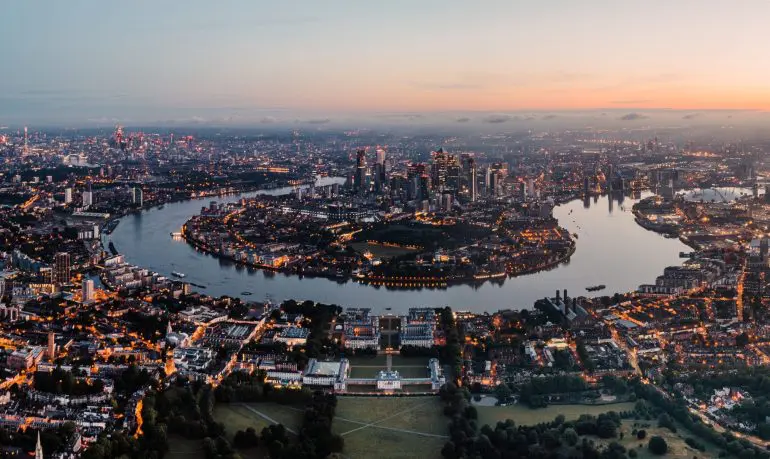Around 10,000 BC, the population of what became the United Kingdom may have been as few as two thousand people. When the Romans arrived in 43 AD, the population was probably closer to seven hundred thousand. By the time of the Norman Conquest in 1066, it has been estimated that there were around 1.7 million people, and when King Charles I was on the throne in 1600, the population was nearer five million. Today, the UK population is approaching seventy million, and many reside in the UK’s biggest cities.
The growth of the largest British cities has been a dynamic process, influenced by myriad factors including industrialisation, migration, and economic development. Historically, the Industrial Revolution marked a significant turning point, catalysing rapid urbanisation and transforming small towns into bustling cities. This period saw an unprecedented movement of people from rural to urban areas, seeking employment in places like factories and mines, which in turn spurred the growth of cities.
Today, the largest cities in the UK are not just economic powerhouses but also hubs of cultural and social activity, each with its own unique identity and heritage. Here are some of the biggest cities in the UK by population, according to figures from the UK’s Office of National Statistics (ONS) and based on urban area.
Measuring the Biggest UK Cities

An elevated view of the London skyline. (Credit: Karl Hendon via Getty Images)
Measuring the size of the largest British cities can be approached in various ways, each offering a different perspective on what constitutes ‘the biggest’.
The most straightforward method is by counting the number of residents within the strict administrative boundaries of the city. However, this can sometimes provide a misleading picture, as it does not account for the urban area which encompasses a city’s adjoining suburbs.
Alternatively, the size of a city can also be measured by its economic output, cultural influence, or geographical area.
For this article, the metric used to measure the largest cities in the UK is the population of the urban area as defined by the ONS. However, it’s also worth noting that the dynamic nature of city growth means that these figures can change quite quickly.
The list below is a snapshot of some of the biggest UK cities by population. For a full list of the top ten, scroll to the bottom of the page.
Belfast | 345,418

Belfast City Hall, Belfast, Northern Ireland (Credit: Allan Baxter via Getty Images)
Belfast is the capital of Northern Ireland and has been settled since the Bronze Age, around 5,000 years ago. One of the biggest cities in the UK, it’s home to the Harland & Wolff shipyard, Europe’s largest dry docks and the yard where The Titanic was built.
Historically, a large producer of linen, the city was affectionately called Linenopolis, and it’s thought the very first public performance of Led Zeppelin’s iconic Stairway to Heaven was at Belfast’s Ulster Hall in March 1971.
Cardiff | 348,535

Aerial view of Cardiff city centre (Credit: Allan Baxter via Getty Images)
The area around the largest city in Wales has been settled for around 8,000 years and Carfiff – Caerdydd in Welsh – is home to Senedd Cymru, or the Welsh Parliament. As late as the beginning of the nineteenth century, Cardiff was little more than a village with the 1801 census registering a population 1,870 people.
Today, Cardiff is one of the largest British cities. It’s the most popular tourist destination in Wales, with around twenty million annual visitors to sites including the mediaeval Cardiff Castle, Cardiff Bay, and the famous William Burges-designed Animal Wall.
Manchester | 470,405

Aerial shot of the city of Manchester, United Kingdom. (Credit: holgs via Getty Images)
One of the biggest cities in the UK, Manchester grew from a small Roman settlement in around 79 AD, close to the confluence of the rivers Irwell and Medlock. The settlement was called Mamucium or Mancunium, and today, residents of Manchester are known as Mancunians.
A boom in textile manufacturing in the nineteenth century was responsible for the town achieving city status in 1853. Among other renowned factors, today the city is home to a number of successful football clubs.
If considering its wider metro area, Manchester has a population of almost two million.
Sheffield | 500,535

View of Sheffield city centre at dusk. (Credit: Ken Fisher Photography and Training via Getty Images)
Named after the River Sheaf, the area in which Sheffield is located is believed to have been settled as far back as the Stone Age, some 13,000 years ago. The largest urban area in South Yorkshire and one of the biggest UK cities, the city is home to Sheffield FC, recognised as the world’s oldest professional football club still playing today.
Sheffield was categorised as a city in 1893 and is perhaps most famous for its steel industry, a crucial element of the advancement of the Industrial Revolution. Today, the city is one of the UK’s greenest, with over 250 parks, gardens and woodlands with an estimated 4.5 million trees.
Liverpool | 506,565

Liverpool Waterfront, United Kingdom. (Credit: Andrea Pistolesi via Getty Images)
The famous home of The Beatles as well as the world’s first intercity rail link – The Liverpool & Manchester Railway – the first written records of the town were as Liuerpul in around 1190 and Leyrpole in the fifteenth century. Liverpool was established as a borough of Lancashire in 1207 and sits on the eastern edge of the Mersey Estuary, bordering the Irish Sea. The town was conferred city status in 1880.
Liverpool, one of the biggest cities in the UK by population, grew to become one of the world’s pre-eminent port cities and in the 1850s was known as ‘the New York of Europe.’ If considering its wider metro area, Liverpool has a population of almost one million.
Leeds | 536,280

Leeds City Square. (Credit: kelvinjay via Getty Images)
The largest city in West Yorkshire in the foothills of the Pennines, Leeds grew from a small thirteenth century manor into an industrial and manufacturing powerhouse by the eighteenth century. One of the biggest UK cities with an urban population of over 500,000, Leeds was conferred city status in 1893.
One of the city centre’s most famous tourist sites is the Victorian-era Kirkgate Market, Europe’s largest covered market with around 800 stalls. It was where Michael Marks and Thomas Spencer opened a penny bazaar in 1884, which grew into the famous Marks & Spencer.
Glasgow | 635,130

Aerial view of Glasgow's prestigious Park District. (Credit: georgeclerk via Getty Images)
The area now known as Glasgow has been settled for thousands of years. What has become the most populous city in Scotland and one of the largest British cities is reputed to have been founded by Kentigern – also known as St. Mungo – in the sixth century, who is said to have built a church where Glasgow Cathedral now stands.
One of Europe’s great cities of culture, Glasgow grew to become one of the world’s largest centres of textile and chemical manufacture during the Industrial Revolution and, most famously, as a builder of great ships including the Cutty Sark, the Aquitania, the RMS Queen Mary and the QE2.
If considering its wider metro area, Glasgow has a population of over 1.5 million.
Birmingham | 1,121,375

Aerial view of Spaghetti Junction in Birmingham, United Kingdom. (Credit: Karl Hendon via Getty Images)
Around 100 miles north of London, Birmingham is often referred to as England’s second city. Evidence of human activity dates back almost 10,000 years and the name comes from the leader of a sixth century Anglo-Saxon tribe named Beorma. Beormingas were ‘Beorma’s people.’
One of the biggest cities in the UK by population, Birmingham was one of the country’s most innovative cities during the Industrial Revolution, and by the late eighteenth century it was known as the world’s first manufacturing town. Almost exactly the geographical centre of England, the greater metropolitan area of Birmingham is home to some 4.5 million people.
London | 9,787,426

Regent Street, London. (Credit: Alexander Spatari via Getty Images)
The capital city of England and the United Kingdom, London is one of the world’s most vibrant and cosmopolitan cities. Founded two thousand years ago by the Romans as Londinium, it’s the most visited city in Europe. The city is famous for its tourist sites, including the Tower of London, St. Paul’s Cathedral, Buckingham Palace and the Natural History Museum. The biggest city in the UK, London is also home to the world’s oldest underground train network and in Heathrow, one of the world’s busiest airports.
List of The Top 10 Biggest Cities in the UK by Population

Clifton Suspension Bridge in Bristol at sunrise. (Credit: Rich Jones Photography via Getty Images)
- London | 9,787,426
- Birmingham | 1,121,375
- Glasgow | 635,130
- Leeds | 536,280
- Liverpool | 506,565
- Sheffield | 500,535
- Manchester | 470,405
- Bristol | 425,125
- Leicester | 406,580
- Cardiff | 348,535
The Evolution of Urban Britain

Aerial photo of the city centre of Leicester in the UK. (Credit: Duncan Cuthbertson via Getty Images)
The biggest UK cities aren’t just population centres, they’re the beating hearts of cultural, economic, and historical significance that define the UK’s rich heritage. From prehistory, through the industrial revolution’s cradle to the modern-day hubs of innovation and diversity, these urban agglomerations showcase the dynamic evolution of society and how nations grow.
The story of the biggest cities in the UK by population is one of continuous growth and transformation, inviting locals and visitors alike to discover the depth and diversity within their bounds.











